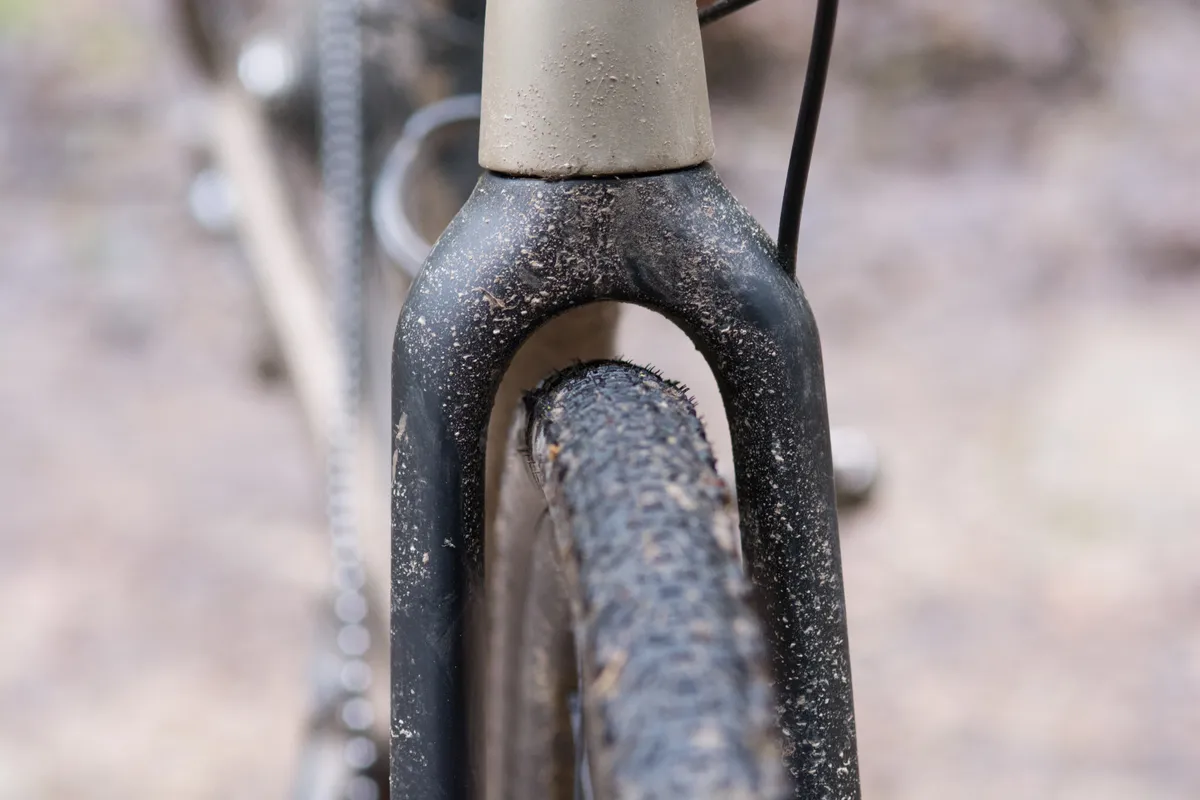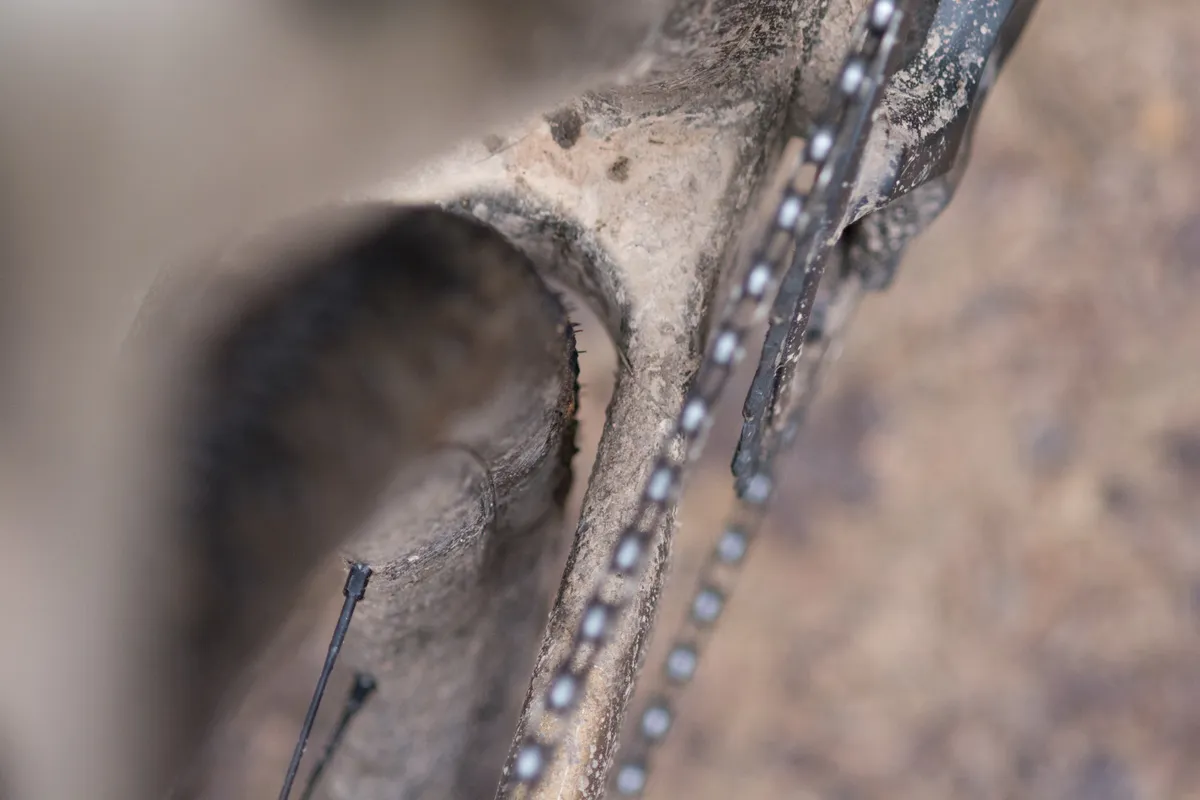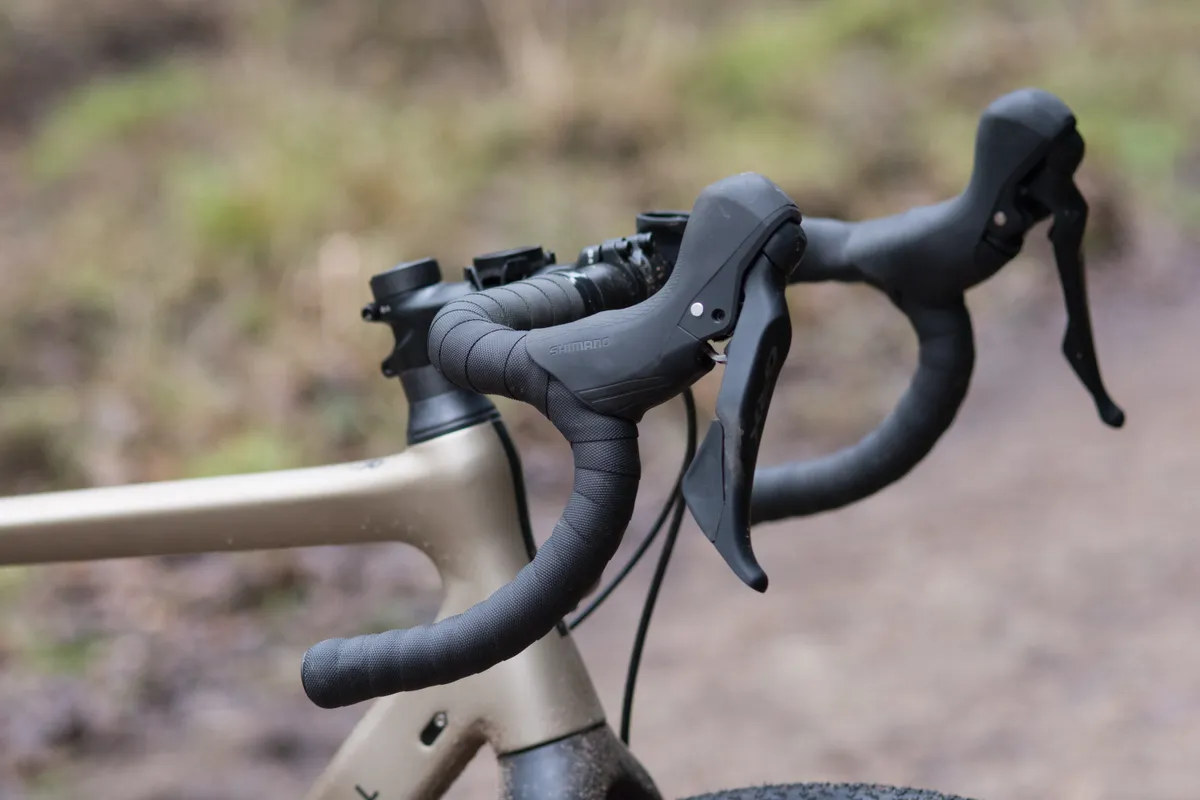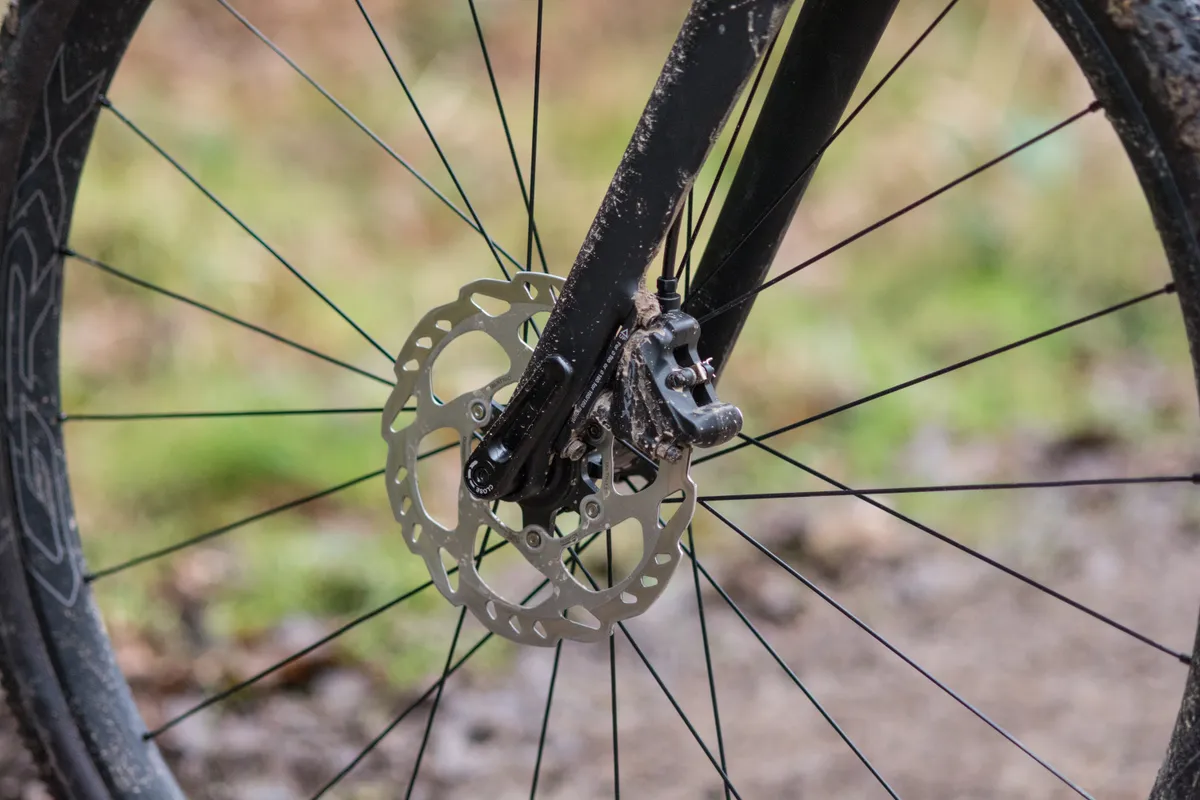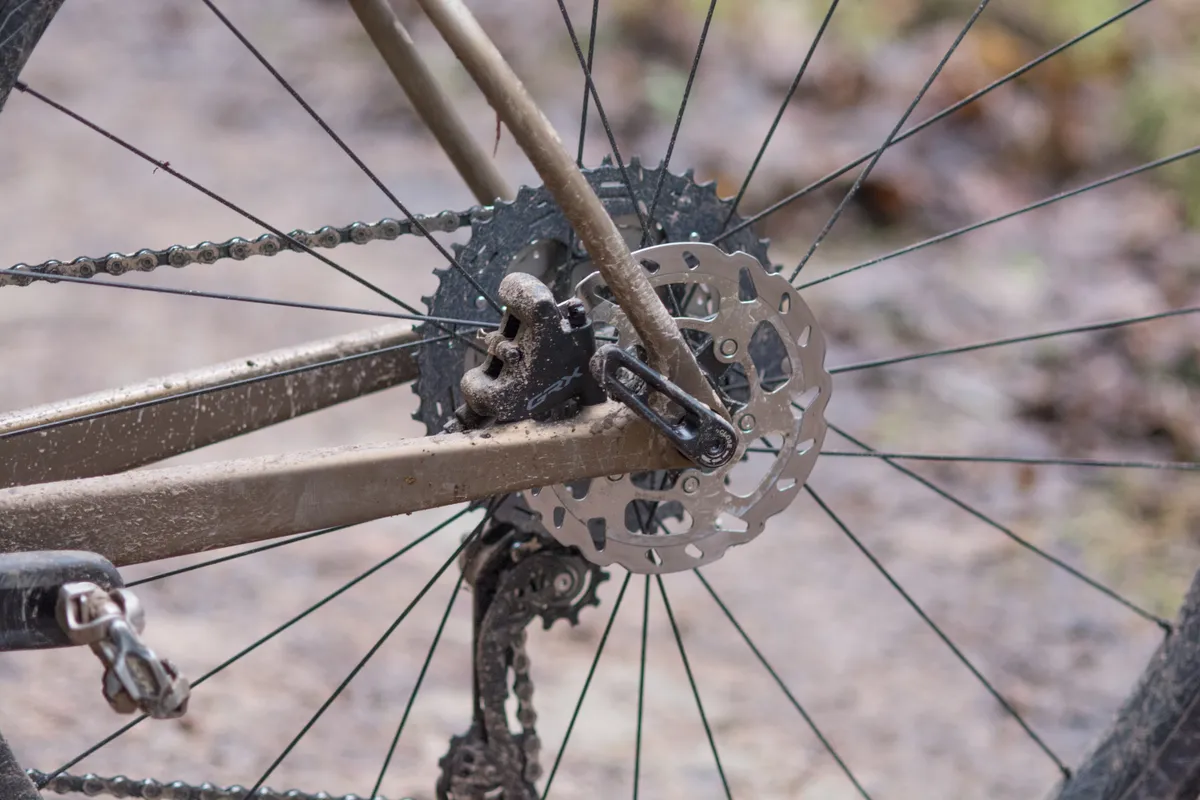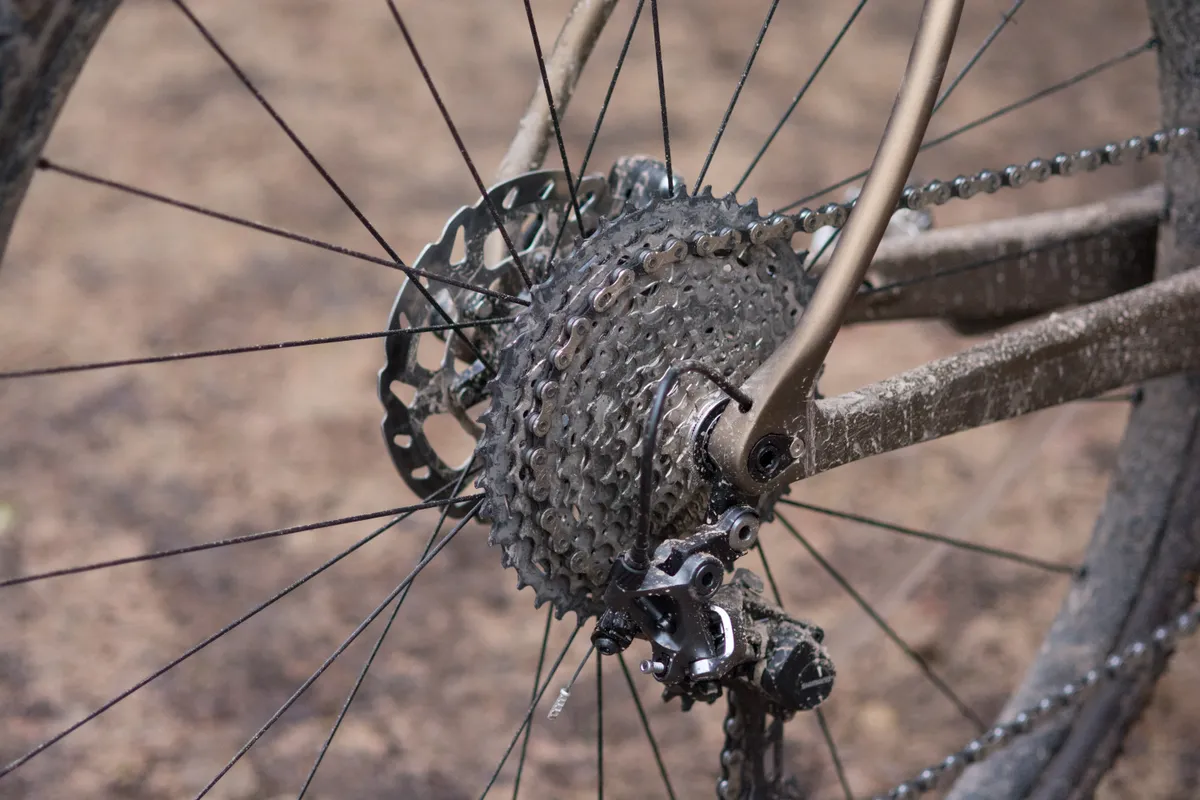The Van Rysel EDR CF Carbon Gravel is a keenly-priced, full-carbon gravel bike with Shimano GRX components, from sports giant Decathlon’s performance-oriented bike brand.
It’s an impressively light bike for the money with good kit, but some spec choices and relatively old-school geometry make it less versatile than some of the competition.
Van Rysel EDR CF frameset
The EDR CF’s frameset is full carbon and sports a handsome gold-fade paint-job that gives the bike a premium feel belying its price-tag.
Claimed weights are 1,020g for the frame and 340g for the fork (including paint), again very respectable numbers for a bike in this price bracket, where much of the competition features significantly heavier aluminium frames.
The overall shape of the bike is quite traditional, with a gently sloping top tube and no dropped seatstays.
Viewed in profile, those stays are ramrod straight but, viewed from behind, they bow out dramatically, presumably to aid rear-end comfort.
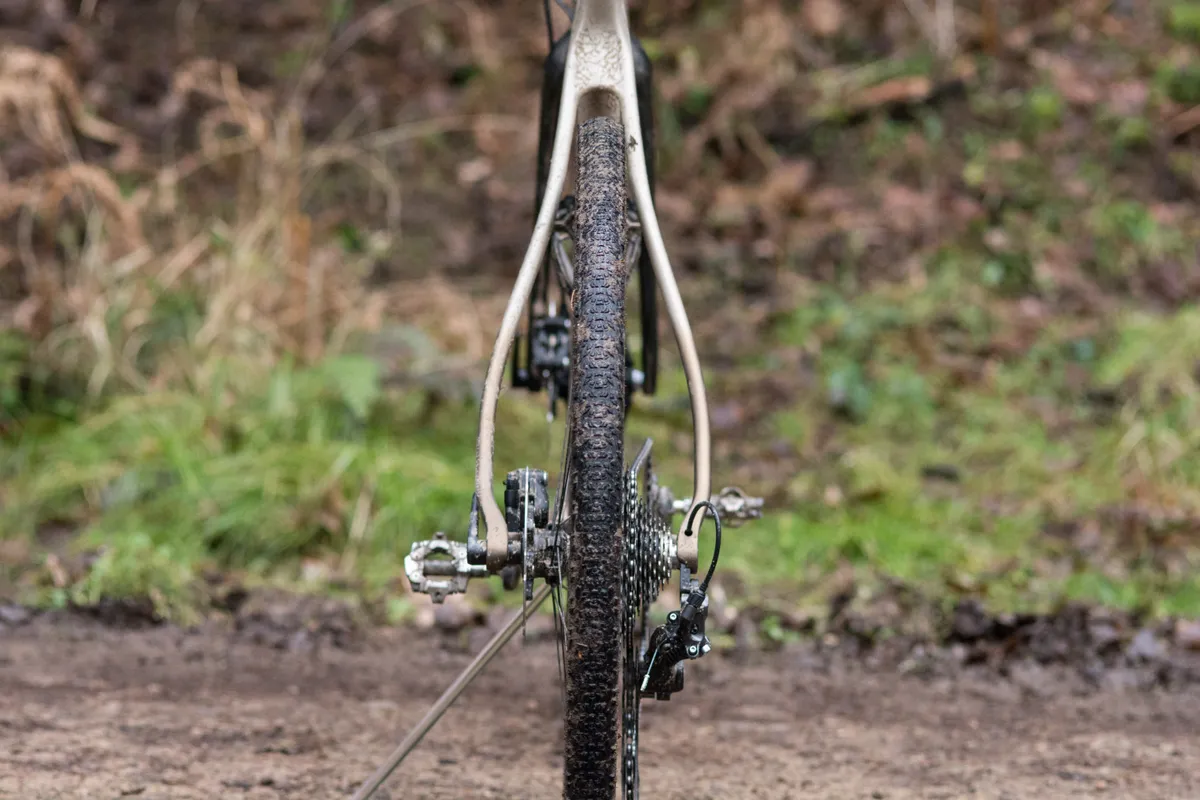
Relatedly, the bike is fitted with a 31.6mm seatpost, rather than the 27.2mm size we’re more used to seeing these days. A narrower diameter seatpost inherently offers more flex.
With a 1× drivetrain and no redundant front derailleur braze-on, the EDR CF is very tidy looking. The cabling is almost fully internal too, although not integrated with the cockpit as is the fashion for superbikes these days.
There’s an unused cable port on the down tube, which could be used for a front derailleur or perhaps even a dropper post if you were so inclined.

The brakes are flat-mount disc, there are 12mm thru-axles front and rear, and the bottom bracket is a press-fit unit.
Finally, there are mounts for two bottle cages (on the size medium and large – the small only gets one), but no other accessories or mudguards.
Van Rysel EDR CF sizing and geometry
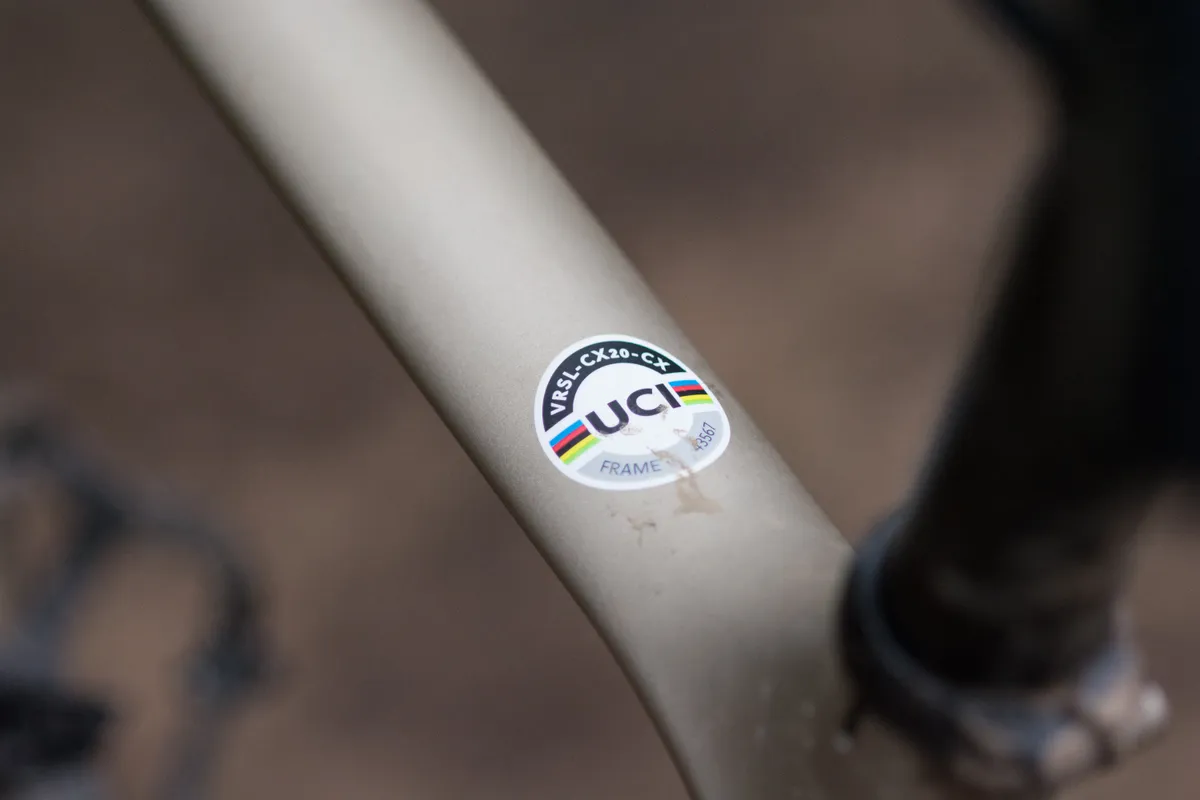
It’s hard to miss the UCI sticker on the EDR CF’s top tube, which denotes approval for cyclocross racing and gives a clue to the bike’s real intentions.
As we’ll get to, I wouldn’t really class the EDR CF as a gravel bike at all, and it’s telling that Decathlon actually sells a cyclocross bike with exactly the same frameset – the Van Rysel RCX CF.
For one thing, the EDR CF’s tyre clearance officially tops out at 700×38mm or 650×42mm. You might get away with slightly larger, but those are not pure gravel bike numbers by today's standards – I expect to see room for at least 700×42mm, if not larger.
The geometry isn’t exactly progressive either. In recent years, gravel bikes have borrowed mountain bike trends, with some bike designers moving to longer reach measurements in tandem with shorter stems as a way to give more confidence-inspiring handling off-road.
A side effect of this approach is to create additional clearance between the front wheel and your feet, avoiding toe overlap and making it possible – on some bikes – to fit mudguards (fenders).
The Canyon Grail 6 is a prime example, with a reach figure of 405mm for a medium and an 80mm stem.
Van Rysel doesn’t go this way and the medium EDR CF has a reach figure of 379mm and a 110mm stem.
Along with frame angles that aren’t far off typical road bike geometry (the head angle is 72 degrees, seat tube angle 73.5 degrees), the wheelbase is a relatively modest (for gravel) 1,010mm, and with my UK size 9 feet, I have substantial toe overlap.
Stack, incidentally, is 561mm for a medium, falling near the racier end of gravel without being too extreme.
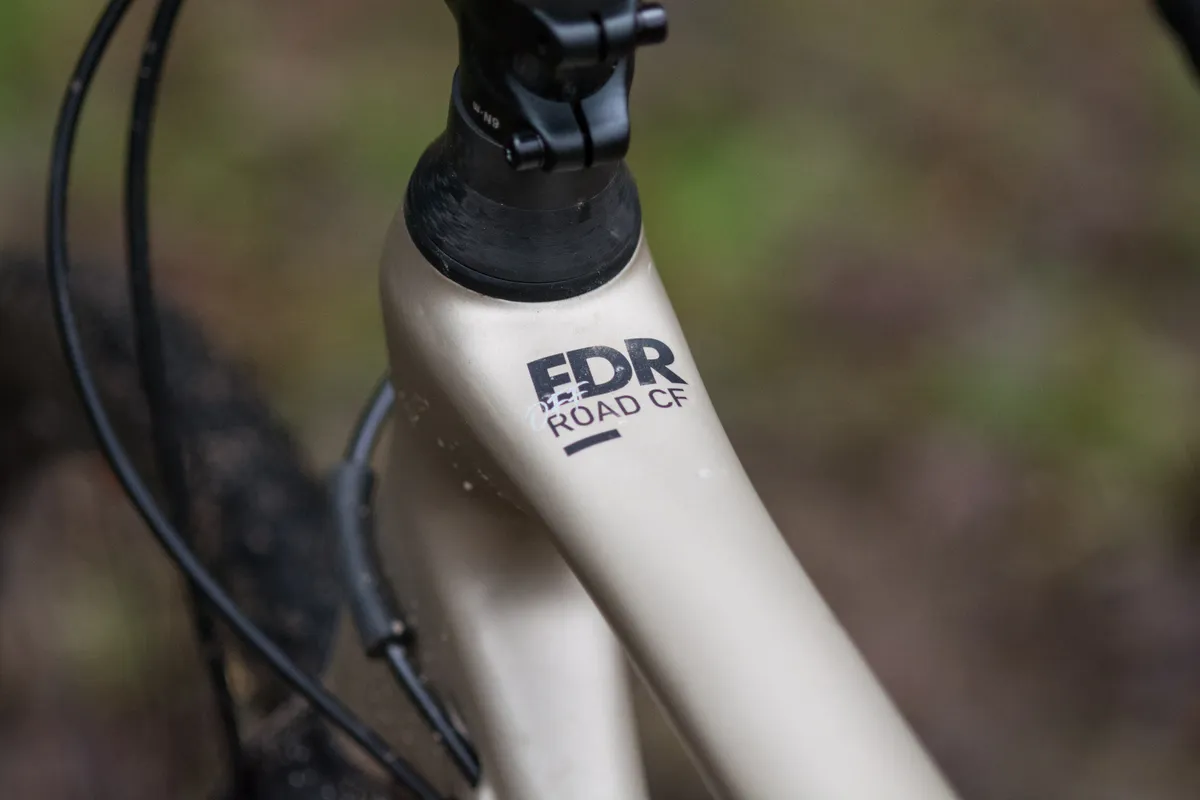
The EDR CF is available in just three sizes (small, medium, large) to cover rider heights from 166cm to 186cm.
At 174cm tall with a saddle height of 71 to 72cm, I was comfortable riding the size medium with the standard stem.
While some Decathlon bikes have a women’s-specific variant, there’s just one unisex model of the EDR CF.
Van Rysel EDR CF build: Shimano GRX 1×
In a market where bike prices are rising sharply, the EDR CF’s biggest draw is its spec.
Despite a recent price increase of £200, the Van Rysel’s build is very competitive, giving you a mixture of Shimano RX600 (105-equivalent) and RX810 (Ultegra-equivalent) drivetrain components, plus RX400 (Tiagra-equivalent) hydraulic disc brakes.
The gearing is very much at the racier end of the spectrum for gravel with a 42t chainring and an 11-42t cassette.
It’s Shimano all the way on the EDR CF, with the aluminium wheels coming from the GRX range too. They’re not particularly exotic or light, but an internal width of 21.6mm and tubeless-compatibility mean they’re ideal for a bike like this.
Gratifyingly, Van Rysel gives you tubeless-ready tyres in the form of 700×38mm Hutchinson Black Mamba CXs.

Decathlon doesn’t ship bikes set up tubeless at the moment, but valves should be included in the box.
The EDR CF’s cockpit and seatpost are in-house aluminium items, and I’ll talk more about the noticeably flared handlebar below. The post is topped with a nice Fizik Antares saddle that’s distinctly roadie in feel.
I weighed the complete size medium bike at 8.9kg, which is really quite light for a bike in its class.
Riding the Van Rysel EDR CF
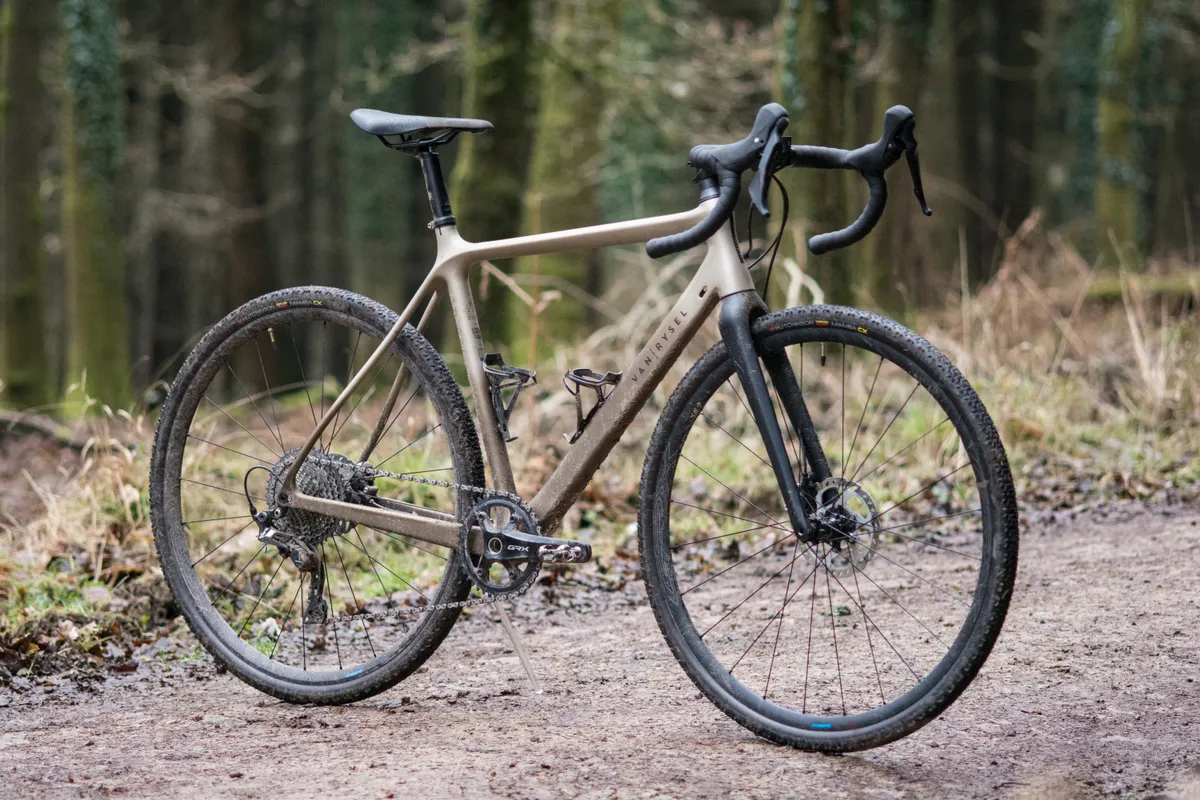
I tested the EDR CF on some of my regular gravel routes around the Forest of Dean, ones that include a variety of surfaces and a certain amount of road riding too.
I hinted at this above, but my overwhelming impression of the EDR CF is that it’s simply not a gravel bike in the truest sense of the term – it’s a cyclocross bike that, at a minimum, needs some spec tweaks to really work as a general-purpose bike.
Let’s talk positives first: the EDR CF is light and stiff and responds well to hard efforts. The Shimano GRX components work flawlessly and the brakes are excellent.
The bike is well suited to riding fast on relatively smooth fire roads and, on the road, it gives up relatively little to an actual road bike.
In fact, the Hutchinson tyres roll surprisingly well on tarmac – the trade-off being that they’re not much use in muddy conditions because they simply don’t have an aggressive enough tread.

The EDR CF is no comfy armchair of a bike though, and that 31.6mm aluminium seatpost does little to cushion the rear end.
Where some gravel bikes can successfully fake it on light mountain bike trails, the stiff Van Rysel is relatively unforgiving.
With any bike in this category, there’s scope to tweak ride comfort by going tubeless and dropping tyre pressures, but there’s no disguising that this is more of a racy CX bike than a squishy gravel grinder.
Officially, you can’t even fit bigger tyres as an alternative without splashing out on an additional 650b wheelset.
Gearing grumbles

The gearing wouldn’t be my first choice either. Van Rysel’s designers say they opted for 1× based on rider feedback and doubtless this will appeal to many, but the pairing of a 42t chainring with Shimano’s 11-42 cassette doesn’t give you a particularly low bottom end, and the gears are quite widely spaced.
It’s fine for faster riding and mucking about in the woods, but I think a 40t ring would serve many riders better and for riding that takes in both road and trail. That's what Canyon opts for on the 1× version of the Grail, and 3T on the Exploro RaceMax.
In fact, the cyclocross version of the EDR CF has a 40t chainring too, although there it's paired with a more closely-spaced 11-32 cassette.
For non-competitive gravel riding, a 40/11 top gear would be perfectly adequate (that's 99.3 gear inches if you're curious) because I find it's rare to feel the lack of a higher top-end on gravel. The Van Rysel's 42/42 bottom end can, however, leave you wanting on the steepest off-road climbs.
In any case, for mixed-terrain riding, I think Shimano’s 2× gearing options are more appealing because they offer both more range and more tightly spaced gears.
I realise gearing is a personal choice to an extent and strong riders will likely be content with the EDR CF's spread of ratios, which aren't totally out of keeping with the bike's apparent intentions – with no mounts for extra luggage and accessories, it's clear that the Van Rysel is aimed at more performance-oriented riders rather than those looking to trundle around laden with stuff.
A flare for bars
I take issue with the choice of handlebar too. It's nominally 42cm wide but, because of the flare, actually measures less than 39cm (centre-to-centre) at the hoods, which is very narrow for gravel riding.
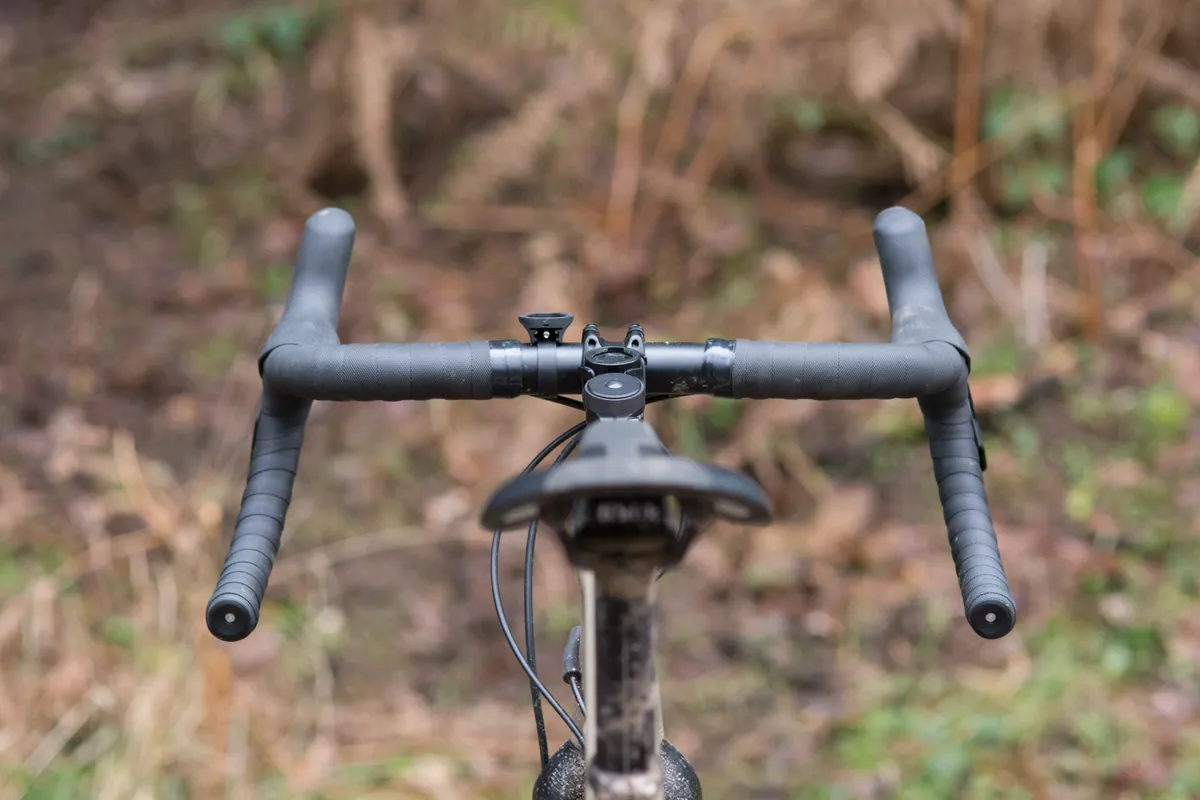
Combined with that long-for-gravel stem and relatively aggressive geometry, the handling is more quick than relaxing.
The argument for flared bars is that the drops give you a wider hand position for technical terrain, but this bar has a relatively deep drop (for gravel) that places you in a position that feels very aggressive on steeper terrain.
Finally, that toe overlap I mentioned earlier is quite significant – it’s not a dealbreaker, but it can catch you out in low-speed manoeuvres.
Van Rysel EDR CF verdict
If you like your gravel machines to have road bike handling and racy manners, the EDR CF may well suit you. Notwithstanding the spec details I've criticised, it's quite suited to fast riding on gravel that falls at the less gnarly end of the spectrum.
On the other hand, if you’re after a comfy bike for distance, load-lugging and properly rough terrain it isn’t the best choice out there.
The EDR CF is really well equipped for the money and could be improved with some spec tweaks, but it falls down on the cheerful versatility that characterises the best gravel bikes, and doesn't offer vastly more off-road ability than the best endurance road bikes.
As a cyclocross bike I’d have fewer quibbles, but I feel it misses the mark for pure gravel and doesn't offers the Swiss army knife-versatility that makes this category of bikes so appealing.
Product
| Brand | vanrysel |
| Price | 2000.00 EUR,1899.00 GBP |
| Weight | 8.9000, KILOGRAM (M) - |
Features
| Fork | Full carbon |
| br_stem | Van Rysel aluminium 110mm |
| br_chain | KMC X11 |
| br_frame | Carbon |
| Tyres | Hutchinson Mamba CX 700×38mm |
| br_brakes | Shimano GRX RX400 |
| br_cranks | Shimano GRX RX810 42t 172.5mm |
| br_saddle | Fizik Antares |
| br_wheels | Shimano GRX WH-RX570 |
| br_shifter | Shimano GRX RX600 1× |
| br_cassette | Shimano SLX 11-42 |
| br_seatpost | Van Rysel aluminium 31.6mm |
| br_bottomBracket | Press-fit (BB86) |
| br_availableSizes | S, M, L |
| br_rearDerailleur | Shimano GRX RX812 |
